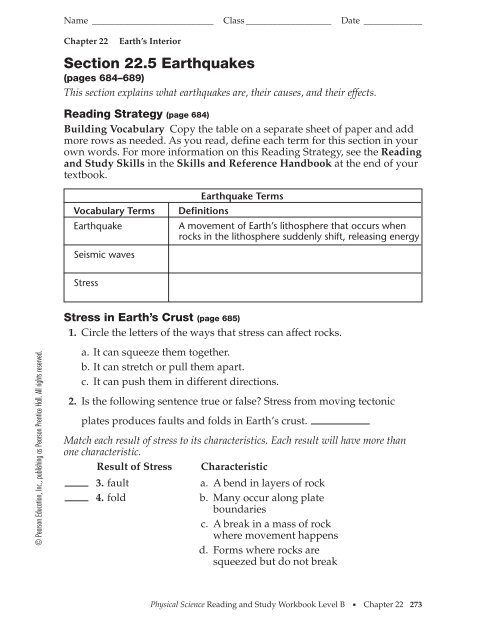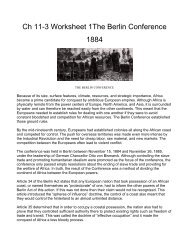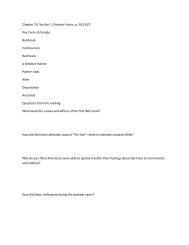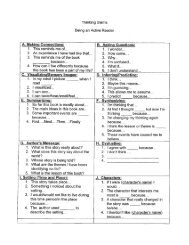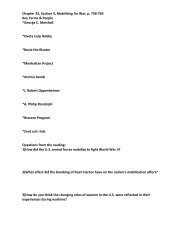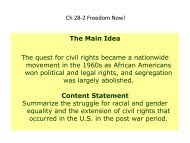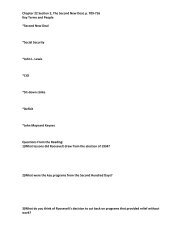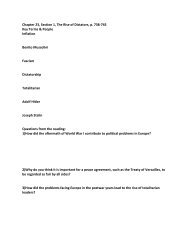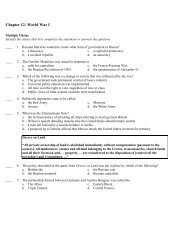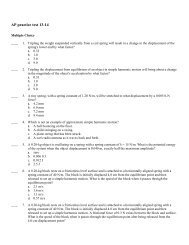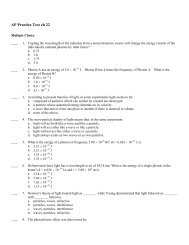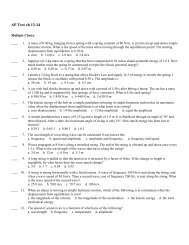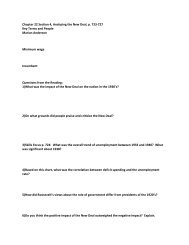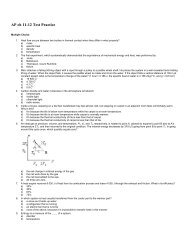22.5 Reading Guide - Geneva Area City Schools
22.5 Reading Guide - Geneva Area City Schools
22.5 Reading Guide - Geneva Area City Schools
Create successful ePaper yourself
Turn your PDF publications into a flip-book with our unique Google optimized e-Paper software.
Name ___________________________ Class ___________________ Date _____________<br />
Chapter 22<br />
Earth’s Interior<br />
Section <strong>22.5</strong> Earthquakes<br />
(pages 684–689)<br />
This section explains what earthquakes are, their causes, and their effects.<br />
<strong>Reading</strong> Strategy (page 684)<br />
Building Vocabulary Copy the table on a separate sheet of paper and add<br />
more rows as needed. As you read, define each term for this section in your<br />
own words. For more information on this <strong>Reading</strong> Strategy, see the <strong>Reading</strong><br />
and Study Skills in the Skills and Reference Handbook at the end of your<br />
textbook.<br />
Vocabulary Terms<br />
Earthquake<br />
Seismic waves<br />
Earthquake Terms<br />
Definitions<br />
A movement of Earth’s lithosphere that occurs when<br />
rocks in the lithosphere suddenly shift, releasing energy<br />
Stress<br />
Stress in Earth’s Crust (page 685)<br />
1. Circle the letters of the ways that stress can affect rocks.<br />
© Pearson Education, Inc., publishing as Pearson Prentice Hall. All rights reserved.<br />
a. It can squeeze them together.<br />
b. It can stretch or pull them apart.<br />
c. It can push them in different directions.<br />
2. Is the following sentence true or false? Stress from moving tectonic<br />
plates produces faults and folds in Earth’s crust.<br />
Match each result of stress to its characteristics. Each result will have more than<br />
one characteristic.<br />
Result of Stress Characteristic<br />
3. fault<br />
4. fold<br />
a. A bend in layers of rock<br />
b. Many occur along plate<br />
boundaries<br />
c. A break in a mass of rock<br />
where movement happens<br />
d. Forms where rocks are<br />
squeezed but do not break<br />
Physical Science <strong>Reading</strong> and Study Workbook Level B ■ Chapter 22 273
Name ___________________________ Class ___________________ Date _____________<br />
Chapter 22<br />
Earth’s Interior<br />
Earthquakes and Seismic Waves (pages 686–687)<br />
5. Is the following sentence true or false? The location underground where<br />
an earthquake begins is called the focus.<br />
6. Define epicenter.<br />
7. Circle the sentences that are true about the physics of earthquakes.<br />
a. Stress builds in areas where rocks along fault lines snag and remain<br />
locked.<br />
b. Potential energy is transformed into kinetic energy in the form of<br />
seismic waves.<br />
c. Potential energy increases as rocks break and move.<br />
Match each type of seismic wave to its characteristic.<br />
Seismic Waves Characteristic<br />
8. P waves<br />
9. S waves<br />
10. surface waves<br />
Measuring Earthquakes (page 687)<br />
11. What devices do geologists use to record seismic waves? Circle the<br />
correct answer.<br />
Richter scale seismograph wave meter<br />
Seismographic Data (page 689)<br />
12. Most earthquakes are concentrated along .<br />
13. Is the following sentence true or false? Some earthquakes will occur in<br />
the interior of plates.<br />
a. Transverse waves that cannot<br />
travel through liquids<br />
b. Slow moving wave that develops<br />
when seismic waves reach<br />
Earth’s surface<br />
c. Longitudinal waves similar to<br />
sound waves that cause particles<br />
in the material to vibrate in the<br />
direction of the waves’ motion<br />
© Pearson Education, Inc., publishing as Pearson Prentice Hall. All rights reserved.<br />
274 Physical Science <strong>Reading</strong> and Study Workbook Level B ■ Chapter 22


